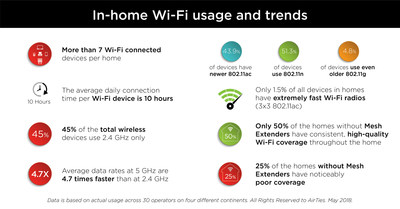

ISTANBUL, Turkey and COLOGNE, Germany, June 7, 2018 /PRNewswire/ -- Ahead of the ANGA COM 2018 conference, AirTies Wireless Networks, the most widely deployed provider of managed Wi-Fi Mesh solutions to global service providers, today disclosed that more than 25 million homes are powered by AirTies' technologies across more than 50 operators on 4 different continents. In addition, the company shared new aggregated, real-world data about key usage patterns for in-home Wi-Fi, and also disclosed customer survey results of Wi-Fi decision makers at service providers that have deployed AirTies.

"Today marks a significant milestone for our company," said Philippe Alcaras, CEO of AirTies. "AirTies technologies now power more than 25 million homes, demonstrating our market scale and proven ability to meet the needs of service providers around the globe. Indeed, the number of homes we serve has doubled over the past three years. More importantly, our customers are reporting increases in customer satisfaction, decreases in Wi-Fi related customer support calls and churn, and the ability to drive incremental revenue from whole-home Wi-Fi."
In-Home Usage Research Findings
AirTies provides leading international service providers with solutions to fix their subscribers' in-home Wi-Fi issues and create premium Wi-Fi services. Today, the company disclosed aggregated data based on actual in-home Wi-Fi usage across millions of households from around the world.
Notably, the average home now has more than 7 Wi-Fi connected devices, and the average daily connection time per Wi-Fi device is 10 hours. This makes Wi-Fi one of the most used services in the home, alongside of utilities such as water and electricity. Not surprisingly; however, in homes without Wi-Fi mesh extenders, only 50% of have consistent, high-quality Wi-Fi coverage throughout the home, and 25% have noticeably poor coverage.
Within the average home, nearly 45% of devices use only 2.4 GHz Wi-Fi channels, while 55% have dual band Wi-Fi chipsets that can operate at 2.4 GHz or 5 GHz. This is important because data rates at 2.4 GHz are noticeably slower. In fact, based on observed data speeds, data rates at 5 GHz are almost 5 times faster than on 2.4 GHz. These findings show the critical importance of network-based client steering technology that can "steer" devices from 2.4 GHz to 5 GHz channels. Proactively steering the 55% of 5 GHz capable devices to 5 GHz not only can improve the speed of those devices by nearly 5 times, but also frees capacity at the more congested 2.4 GHz, which in turn improves the performance of older legacy devices in the home. Relatedly, in households with 5GHz devices, DFS spectrum-sharing with radar channels is used 80% of the time, demonstrating the importance of choosing in-home Wi-Fi systems that are capable of taking advantage of DFS, in order to maximize performance at 5 GHz.
New Wi-Fi standards continue to evolve and improve, but that does not mean legacy devices go away, and service providers need to have systems in place to identify and understand the device profiles of their subscribers' homes. Indeed, nearly 5% of devices in homes use very old 802.11g Wi-Fi technology, 51.3% of devices in the home still use old 802.11n, and only 43.9% of devices have newer 802.11ac Wi-Fi technology. However, only 1.5% of all devices in homes today have extremely fast embedded Wi-Fi radios (3x3 802.11ac) capable of achieving 1.3 Mbps PHY rate (i.e. high-end laptops). Understanding all Wi-Fi device performance characteristics, limitations, and behavior in subscribers' homes can enable customer call centers to address issues more effectively, and highlights the need for cloud-based performance monitoring and management.
Service Provider Survey Findings
Separately, AirTies conducted a customer survey of Wi-Fi decision makers at more than a dozen leading service providers who have deployed AirTies Managed Mesh Wi-Fi solution. Key results from that survey include the following:
At ANGA COM 2018, AirTies will be located in Hall 8, MS17. Additional information about AirTies can be found at: www.AirTies.com.
About AirTies
Founded in 2004, AirTies is the most widely deployed provider of Wi-Fi Mesh solutions to operators around the globe. AirTies provides service providers with Mesh extenders, set-top boxes, software, apps, and cloud-based performance monitoring capabilities that enable ISPs to provide a managed Wi-Fi Mesh solution for their subscribers. AirTies technologies are powering more than 25 million homes worldwide. AirTies' customers include: AT&T, Atlantic Broadband, Deutsche Telekom, Frontier, Orange, Midco, Singtel, Sky (SKY Q in the UK; Germany; Italy; and New Zealand), Swisscom, Vodafone, Waoo, and many other operators. More information is available at www.AirTies.com.
SOURCE AirTies